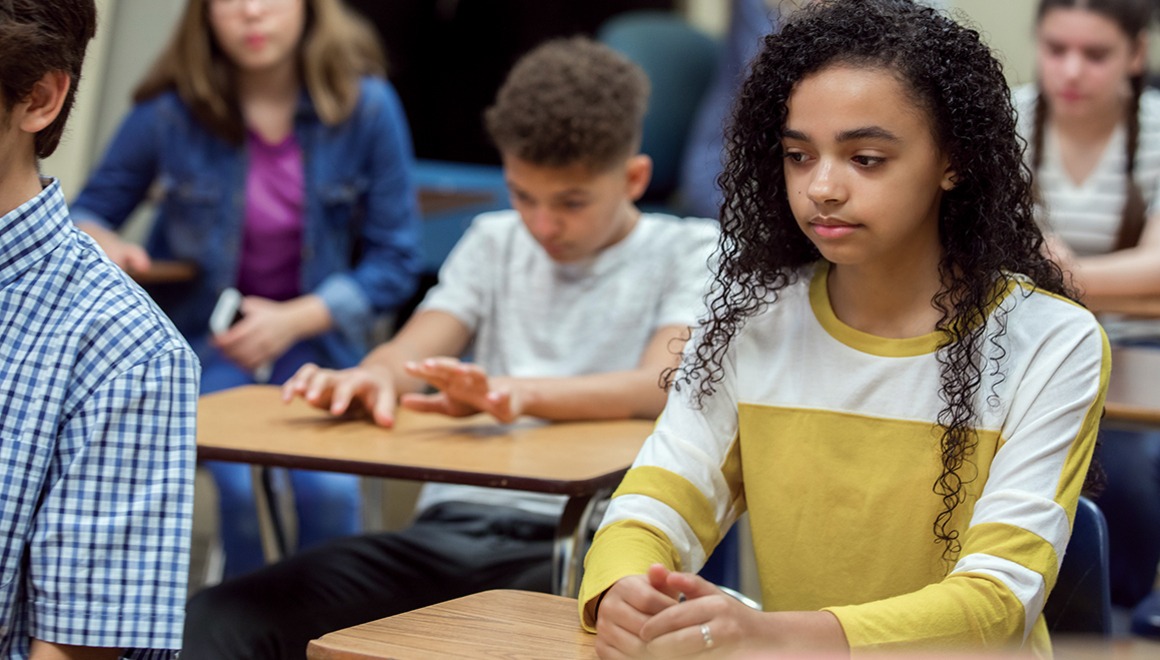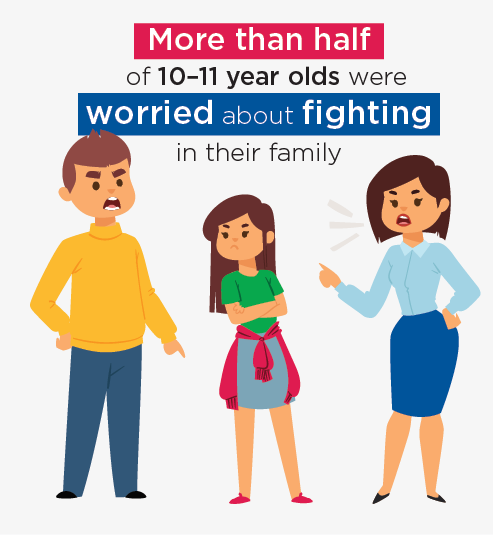12. Tweens and teens: What do they worry about?
12. Tweens and teens: What do they worry about?

Introduction
As young people move through childhood and adolescence, they experience many changes. Their bodies mature, thought processes become more complex (Arain et al., 2013; Raising Children Network, 2017) and their relationships with parents and friends typically change (Brown & Larson, 2009; Paikoff, & Brooks-Gunn, 1991; Yu & Baxter, 2018). Schoolwork and homework often become more demanding (Raising Children Network, 2019), and balancing school, family and extracurricular demands can become challenging (Hardy, 2003). Added to this are concerns about the environment (Queensland Family and Child Commission, 2018) and global issues such as terrorism (UNICEF, 2013) - therefore, it is not surprising that many young people worry.
Some degree of anxiety is normal when faced with change or uncertainty (Einstein, 2015; Greco & Roger, 2003). In fact, worrying can be a useful response in particular circumstances because it helps a person to anticipate potential 'threats' to their wellbeing and make preparations to avoid them (Guitérrez-García & Contreras, 2013). However, parents and society can trivialise children's concerns. It is important to understand what children and young people worry about in order to support them to deal with these concerns effectively, so that they do not become overwhelming and negatively affect their mental health (Queensland Family and Child Commission, 2018). Research suggests that the more worries children have, the more likely they are to become anxious or depressed (Brown, Teufel, Birch, & Kancheria, 2006).
Box 12.1: Worries
In 2014 and 2016, when the B cohort were aged 10-11 and 12-13, respectively, they were asked how worried they were about the following issues:
- the environment
- terrorism/war
- use of alcohol and other drugs by children or teenagers
- someone in your family becoming seriously ill or injured
- people in your family fighting
- parents losing their job
- the way you look
- not fitting in with your friends
- not doing well at school
- starting high school.
Responses were made using a four-point scale: 1 = 'not at all worried'; 2 = 'a little worried'; 3 = 'fairly worried'; 4 = 'very worried'. For simplicity of presentation, children's responses were combined ('not at all worried/a little worried' vs 'fairly worried/very worried') and only the percentage who responded 'fairly worried/very worried' are reported.
Items adapted from the Children's Worries and Concerns Scale (Tucci, Mitchell, & Goddard, 2006).
Studies undertaken several decades ago indicated that the most frequent sources of worry among children and teens were family, school and personal health (Silverman, Greca, & Wasserstein, 1995; Simon & Ward, 1974). Recent Australian research has found that children now worry about coping with stress, school or study problems, and their mental health (Carlisle et al., 2018). Bullying (including cyberbullying), education, drugs and alcohol, climate change, the environment and employment have also been identified as issues causing Australian children to worry.
When LSAC B cohort participants were aged 10-11 (in 2014) and 12-13 (in 2016) they were asked how worried they were about a range of issues relating to themselves, school, their families, and global issues. This chapter uses this data to examine what issues concern Australian children and whether these worries change, as young people move from being 'tweens' to 'teens'. Comparisons are made between girls and boys, children from different family and cultural backgrounds and those living in country and city areas, to see if they differ in their levels of worry and what they worry about. This information may be helpful for parents and educators to support children and teens to build their resilience now and as they move through adolescence.
12.1 What do teens and tweens worry about?
The LSAC data show that the issues of greatest concern among 10-11 year olds in 2014 and 12-13 year olds in 2016 related to their families (Table 12.1), although a higher proportion of children worried about this at age 10-11 than at 12-13 years.
Worrying about the health of family members was the most common concern among children at both 10-11 and 12-13 years. Two in three 10-11 year olds said that they were worried about a family member becoming seriously ill or injured, more than half were concerned about fighting within their family, and more than four in 10 children were worried about their parents losing their job. By the age of 12-13, the level of worry about family issues had declined. Nevertheless, family issues remained a prominent concern among this age group, with around six in 10 teens worrying about the health of family members, and about four in 10 concerned about family fighting and parental job loss. These findings are consistent with other studies, which have shown that children are affected by family circumstances such as conflict among family members and parents' economic and health problems (Campo, 2015; Gambaro & Joshi, 2016).
Figure 12.1: More than half of 10-11 year olds were worried about fighting in their family

Credit: Longitudinal Study of Australian Children 2019 (creativecommons.org/licenses/by/4.0/)
Notes: n for each of the eight items ranged from 3,572 to 3,575.
Source: LSAC Waves 6 and 7, B cohort, weighted
Global issues were another major concern among children at both ages, although some age-related differences were noted. At both ages, about four in 10 children said that they were worried about terrorism and war. Due to advances in electronic media, information about social issues and world events is easily accessible on various media platforms. Consequently, children today are more likely to become aware of distressing events such as war or terrorist attacks through TV, the internet or social media. Exposure to such information via the mass media can fuel fear and worries about these issues (Vasterman, Yzermans, & Dirkzwager, 2005).
The use of drugs and alcohol by teenagers and children was also a concern for many LSAC children (44% at 10-11 years), although this appeared to become less of an issue once they reached their early teens (37% identified this as a concern at 12-13 years). It is possible that as children aged, they experienced more exposure to this behaviour (via the media and peers), reducing their anxiety about this issue (Anderson, Kochanek, & Murphy, 2009; Strasburger, 2010).
Concern about the environment remained fairly stable over time with about one in three children worrying about this at age 10-11 and 12-13. The incidence of natural or environmental disasters has increased steadily worldwide, with millions of people, including children, affected (Leaning & Guha-Sapir, 2013; Ritchie & Roser, 2014; UNICEF, 2014). Children around the world are aware of climate change and are concerned about its impact on their own lives and the lives of other children (UNICEF, 2013). This is reflected in recent protests by young activists around the world expressing concerns about climate change (e.g. Menzie-Ballantyne, 2019).
Changing schools was an issue of greater concern for children at age 10-11 (the late primary school years for most) than at 12-13 (the early secondary school years for the majority), with four in 10 children aged 10-11 years indicating that they were worried about this. The transition from primary to secondary school is considered to be an important turning point in young people's lives, often requiring them to make new friends and adapt to new school settings, routines and academic expectations (Hanewald, 2013). In contrast, not doing well at school was a greater issue among 12-13 year olds, with almost four in 10 identifying this as a worry. Schooling is frequently identified as a major source of stress and worry among children and teens (Carlisle et al., 2018; Raising Children Network, 2019). In today's competitive environment, children are under great pressure to do well at school (Hardy, 2003).
The issues of least concern to study children related to how they looked and whether they fit in with their friends, although a sizeable proportion (between 18% and 26%) still worried about these issues. It is possible that concerns about these issues may increase as children move through adolescence and peer relationships become more important. This has been explored in previous LSAC research (Gray, Romaniuk, & Daraganova, 2017).
12.2 Characteristics of children who worry
Worrying is a normal reaction to change and uncertainty (Einstein, 2015; Greco & Roger, 2003). However, people differ in how well they tolerate uncertainty, with those who find it particularly difficult being more vulnerable to becoming anxious and depressed (Grupe & Nitschke, 2013). Previous research also suggests that individual attributes such as personality can influence how much a person worries (Alizadeh et al., 2016; Toumbourou, Williams, Letcher, Sanson, & Smart, 2011). However, many other factors may influence what children worry about. These include their age, gender, the type of family and social and political environment they grow up in, as well as their exposure to information via social and mass media (Barahmand, 2008; Brown et al., 2006; Grist & Field, 2012; Lupien, King, Meaney, & McEwen, 2000; Tikkanen, 2016).
The LSAC data were used to identify whether children with particular characteristics worried more and, if so, what they worried about. While many factors are likely to influence the extent to which children and teens worry about particular issues, this chapter focuses on gender, family characteristics, cultural background and residential location.
Gender differences
The LSAC data show that a higher percentage of girls than boys were worried about most of the issues addressed in the survey. (Table 12.2). Although this gender difference was evident at both 10-11 (in 2014) and 12-13 years (in 2016), for many issues it increased as children got older.
The issues with the greatest difference between girls and boys were worries about how they looked and fitted in with friends (Table 12.2). These differences were particularly evident at age 12-13. Around one in three girls said that they were worried about their appearance at age 12-13, and almost one in four were worried about fitting in with friends (compared to only about one in seven boys for both issues). This finding is strongly supported by other research that has shown that girls tend to be less satisfied with their bodies than boys (O'Connor, Warren, & Daraganova, 2018) and may experience greater pressure to conform to societal ideals of beauty (Grabe, Ward, & Hyde, 2008; Voelker, Reel, & Greenleaf, 2015).
Notes: Population weighted results. Asterisks (marked in the second column of each age group) indicate statistically significant differences in proportions between boys and girls, from chi-square tests: * p < .05, ** p <. 01, *** p < .001.
Source: LSAC Waves 6 and 7, B cohort
The only issue that concerned boys more than girls was the possibility that one of their parents may lose their job - almost half (49%) of boys indicated that they worried about this at age 10-11, compared to 42% of girls.
Family influences
Children from less advantaged families (as measured by parents' income and education) worried more, about a range of issues, than children from more advantaged families (Tables 12.3 and 12.4). These results are not unexpected, given that research suggests that children who experience disadvantage are more likely to be exposed to more stressful living conditions (e.g. lower quality housing, less responsive parenting and higher neighbourhood crime) than more advantaged children (Brooks-Gunn & Duncan, 1997; Evans, Brooks-Gunn, & Klebanov, 2011; Warren & Edwards, 2017).
Parental education had a more widespread influence on children's worries at age 10-11 than parental income, with children of parents with no post-secondary school qualifications reporting higher levels of concern about most issues (Table 12.3). However, by age 12-13 most of these differences had disappeared. In comparison, parental income was strongly and consistently associated with children's worries but only in specific areas - namely, their families, changing schools and alcohol and drug use among children and teens (Table 12.4).
While family-related issues were a common concern among tweens and teens generally, they appeared particularly concerning for children from less advantaged backgrounds. For instance, about a half of children whose parents had not completed any post-school qualifications were worried about parental job loss at age 12-13 (compared to one in three children who had at least one parent with a tertiary degree), as were four in 10 of children from low-income families (compared to a quarter of children in high-income families).
Changing schools was another common issue of concern among children from less advantaged backgrounds, possibly due to higher rates of residential mobility often observed among families experiencing disadvantage (Phinney, 2013).
Notes: Population weighted results. Year 12 or less = both parents did not have any post-secondary qualifications; Certificate or Diploma = at least one parent completed a Certificate, Diploma or Advanced Diploma; Degree = at least one parent completed a Bachelor's Degree or a higher qualification. Asterisks (marked in the second column of each age group) indicate statistically significant differences from the reference group (Year 12 or less), from chi-square tests: * p < .05, ** p < .01, *** p < .001.
Source: LSAC Waves 6 and 7, B cohort
Notes: Population weighted results. Low = lowest 25%, Middle = middle 50%, High = highest 25% on parental income. Asterisks (marked in the second column of each age group) indicate statistically significant differences from the reference group (low income), from chi-square tests: * p < .05, ** p < .01, *** p < .001.
Source: LSAC Waves 6 and 7, B cohort
Culturally and linguistically diverse background (CALD)
Children from culturally and linguistically diverse (CALD) families in Australia generally worried more than children from non-CALD families (Table 12.5). These worries became more wide-ranging as children got older. As noted earlier, the transition to adolescence can be a difficult time for many young people. This may be particularly so for children from CALD backgrounds, who may face additional challenges to peers, such as difficulties learning English, discrimination, intergenerational conflict and feelings of displacement (Child Family Community Australia [CFCA], 2015; Commissioner for Children and Young People WA, 2016).
Children from CALD families were more worried about family issues such as the health of family members, family conflict and parental employment. They were also more worried about doing well at school than children from non-CALD families, with almost half (48%) indicating that this was a worry for them at 12-13 years (compared to four in 10 teens from non-CALD families).
Another area of greater concern for these children and teens was global issues such as terrorism and war, the environment, and drug and alcohol use among children and teenagers. For instance, at age 12-13, more than half (55%) of teens from CALD families indicated that they were concerned about terrorism compared to four in 10 (42%) teens of non-CALD families.
Notes: Population weighted results. Asterisks (marked in the second column of each age group) indicate statistically significant differences in proportions between children from CALD backgrounds and non-CALD backgrounds, from chi-square tests: * p < .05, ** p < .01, *** p< .001.
Source: LSAC Waves 6 and 7, B cohort
Geographic location
Overall, where children lived was not related to what they worried about, with children and teens living in city and country areas generally worrying about similar things (Table 12.6). However, some differences were noted. Compared to children who lived in metropolitan areas, more children who lived in non-metropolitan areas reported being worried about how they looked and about changing schools. However, group differences were quite small and were only found at age 10-11. In comparison, at age 12-13, children who lived in metropolitan areas worried more about their academic performance and about terrorism and war - possibly because cities are often the targets of terrorist attacks (Burke, 2018). Once again, group differences were quite small.
Notes: Population weighted results. Asterisks (marked in the second column of each age group) indicate statistically significant differences in proportions between children from metropolitan and non-metropolitan areas, from chi-square tests: * p< .05, ** p < .01, *** p < .001.
Source: LSAC Waves 6 and 7, B cohort
Summary
Tweens and teens in this study mostly worried about issues related to their families. Two in three 10-11 year olds (in 2014) were worried about a family member becoming seriously ill or injured, and more than half were concerned about fighting within their family. Family-related issues were also the top concern for 12-13 year olds (in 2016). Given the extent to which 10-14 year olds typically rely on their families for financial, practical and emotional support and guidance, these results are not surprising. However, it would be interesting to know whether parents are aware of how much children worry about issues within the family. The current findings suggest that support might be needed to help children to deal with family-related issues.
School is frequently identified as a major source of stress and worry among children and teens, and this was reflected in the LSAC findings. The aspects of school life that worried children varied with age. Changing schools was a much bigger concern at age 10-11 (when most were in their late primary school years) than at 12-13 (when most were in secondary school), with four in 10 children indicating that this was a worry. The upcoming transition from primary to secondary school was likely to be concerning many. As children as young as 10 were worrying about moving schools, it is possible that preparation for the transition to secondary school may need to begin earlier than it does currently (typically in Year 6). In comparison, academic performance was an issue of greater concern at age 12-13 than at 10-11. Four in 10 teens were worried about not doing well at school. Due to testing and pressures to perform well, children can often feel anxious (McDonald, 2001). Therefore, teens could benefit from further support to help them manage academic expectations, particularly in the early years of secondary school.
Two of the key areas that children and teens worried about - family and school - were also identified as major sources of worry among children and teens in international studies conducted in the 1970s and 1990s (Silverman et al., 1995; Simon & Ward, 1974), as well as in a recent Australian study on young children (Redmond et al., 2016). This suggests that these are typical areas of concern for children and teens.
The LSAC data showed that in 2014 and 2016 many Australian children were concerned about global issues such as terrorism and war (four in 10), the environment (one in three) and alcohol or drug use among children and teenagers (four in 10). These issues were particularly concerning for children from CALD backgrounds. Children and teens often look to parents and other adults in their lives for guidance on how to interpret and respond to these events. Given the high level of concern about global issues among children, initiatives aimed at educating parents, teachers and other relevant professionals on how best to discuss such issues with children are likely to be beneficial. This may involve further promotion and dissemination of resources that have already been developed for this purpose (see e.g. Child Mind Institute, 2015).
Concerns about personal appearance and fitting in with friends ranked lowest among the issues children were asked about, although a sizeable proportion of children (between 18% and 26%) worried about their looks and fitting in with others. Significantly more girls than boys worried about these issues. As girls may experience a greater pressure to conform to social expectations about their physical appearance, it is understandable that they may feel particularly vulnerable about their appearance and 'fitting in' at this life stage, when their bodies are changing.
Looking at the characteristics of those who worried most, age appeared important. The percentage of children who worried about particular issues generally decreased between ages 10-11 and 12-13, suggesting that the late childhood (tween) years may be a time when children are more vulnerable to anxiety or stress, and could benefit from additional support. Consistent with previous research, girls generally worried more than boys, as did children from CALD and less socio-economically advantaged backgrounds, who may face additional challenges to other children. The findings presented in this chapter may help parents and educators to understand what children worry about. Given that children who worry a lot are more prone to anxiety and depression (Brown et al., 2006), analysis of future waves of LSAC data could provide a valuable understanding of how children and adolescents' worries change over time.
References
Alizadeh, Z., Feizi, A., Rejali, M., Ashfar, H., Hassanzadeh Keshteli, A., & Peyman, A. (2016). The predictive value of personality traits for psychological problems (stress, anxiety, and depression): Results from a large population based survey. Journal of Epidemiology and Global Health, 8(3-4), 124-133.
Anderson, P., Kochanek, K., & Murphy, R. (2009). Impact of alcohol advertising and other media exposure on adolescent alcohol use: A systematic review of longitudinal studies, Alcohol and Alcoholism, 44(3), 229-243.
Arain, M., Haque, M., Johal, L., Mathur, P., Nel, W., Rais, A. et al. (2013). Maturation of the adolescent brain. Neuropsychiatric Disease and Treatment, 9, 449-461.
Barahmand, U. (2008). Age and gender differences in adolescent worry. Personality & Individual Differences, 45, 778-783. dx.doi.org/10.1016/j.paid.2008.08.006
Brooks-Gunn, J., & Duncan, G. J. (1997). The effects of poverty on children. The future of children, 55-71.
Brown, B. B., & Larson, J. (2009). Peer relationships in adolescence. In R.M. Lerner & L. Steinberg (Eds.), Handbook of adolescent psychology, Volume 2 (pp. 74-103). New York: John Wiley and Sons, Inc.
Brown, S. L., Teufel, J. A., Birch, D. A., & Kancherla, V. (2006). Gender, age, and behavior differences in early adolescent worry. Journal of School Health, 76, 430-437. Retrieved from dx.doi.org/10.1111/j.1746-1561.2006.00137.x
Burke, J. (2018, 29 January). Cities and terror: An undivisible and brutal relationship. The Guardian.
Campo, M. (2015). Children's exposure to domestic and family violence (CFCA Paper No. 36). Melbourne: Australian Institute of Family Studies.
Carlisle, E., Fildes, J., Hall, S., Hicking, V., Perrens, B., & Plummer, J. (2018). Youth survey report 2018. Sydney, NSW: Mission Australia.
Child Family Community Australia (CFCA). (2015). Working with culturally and linguistically diverse (CALD) adolescents (CFCA Practitioner Resource). Melbourne: CFCA.
Child Mind Institute (2016). Helping children cope after a traumatic event. New York: Child Mind Institute.
Commissioner for Children and Young People WA. (2016). Children and young people from culturally and linguistically diverse backgrounds speak out. Perth, WA: Commissioner for Children and Young People WA.
Einstein, D. (2015, 27 March). Life is full of uncertainty, we've just got to learn to live with it. The Conversation. Retrieved from theconversation.com/life-is-full-of-uncertainty-weve-just-got-to-learn-to-live-with-it-30092
Evans, G. W., Brooks-Gunn, J., & Klebanov, P. K. (2011). Stressing out the poor: Chronic physiological stress and the income-achievement gap. Pathways, Winter.
Gambaro, L., & Joshi, H. (2016). Moving home in the early years: what happens to children in the UK? Longitudinal and Life Course Studies, 7(3), 265-287.
Grabe, S., Ward, L. M., & Hyde, J. S. (2008). The role of the media in body image concerns among women: A meta-analysis of experimental and correlational studies. Psychological Bulletin, 134(3), 460-476.
Gray, S., Romaniuk, H., & Daraganova G. (2018). Adolescents' relationships with their peers. In Australian Institute of Family Studies (Ed.), Growing Up in Australia: The Longitudinal Study of Australian Children. Annual Statistical Report 2017. Melbourne, Vic: Australian Institute of Family Studies.
Greco, V., & Roger, D. (2003). Uncertainty, stress, and health. Personality and Individual differences, 34(6), 1057-1068.
Grist, R. M., & Field, A. P. (2012). The mediating effect of cognitive development on children's worry elaboration. Journal of Behavior Therapy & Experimental Psychiatry, 43, 801-807. dx.doi.org/10.1016/j.jbtep.2011.11.002
Grupe, D. W., & Nitschke, J. B. (2013). Uncertainty and anticipation in anxiety: An integrated neurobiological and psychological perspective. Nature Reviews Neuroscience, 14(7), 488.
Guitérrez-García, A. G., & Contreras, C. M. (2013). Anxiety: An adaptive emotion. New Insights into Anxiety Disorders. Federico Durbano, IntechOpen, DOI: 10.5772/53223. Retrieved from www.intechopen.com/books/new-insights-into-anxiety-disorders/anxiety-an-...
Hanewald, R. (2013). Transition between primary and secondary school: Why it is important and how it can be supported. Australian Journal of Teacher Education, 38(1).
Hardy, L. (2003). Overburdened, overwhelmed. American School Board Journal, 190(4), 18-23.
Leaning, J., & Guha-Sapir, D. (2013). Natural disasters, armed conflict, and public health. New England Journal of Medicine, 369(19), 1836-1842.
Lupien, S. J., King, S., Meaney, M. J., & McEwen, B. S. (2000). Child's stress hormone levels correlate with mother's socioeconomic status and depressive state. Biological Psychiatry, 48, 976-980. dx.doi.org/10.1016/S0006-3223(00)00965-3.
McDonald, A. S. (2001). The prevalence and effects of test anxiety in school children. Educational Psychology, 21(1), 89-101.
Menzie-Ballantyne, K. (2019, 14 March). Students striking for climate action are showing the exact skills employers look for. The Conversation. Retrieved from theconversation.com/students-striking-for-climate-action-are-showing-the-exact-skills-employers-look-for-113546
Paikoff, R. L., & Brooks-Gunn, J. (1991). Do parent-child relationships change during puberty? Psychological Bulletin, 110, 47-66.
Phinney, R. (2013). Exploring residential mobility among low-income families. Social Service Review, 87(4), 780-815.
Queensland Family and Child Commission (2018). This place I call home: The views of children and young people on growing up in Queensland. Queensland: Queensland Family and Child Commission.
Raising Children Network (2017). Physical changes in puberty: boys and girls. Retrieved from raisingchildren.net.au/pre-teens/development/puberty-sexual-development/physical-changes-in- puberty
Raising Children Network (2019). Stress in teenagers. Retrieved from raisingchildren.net.au/teens/mental-health-physical-health/stress-anxiety-depression/stress-in-teens
Redmond, G., Skattebol, J., Saunders, P., Lietz, P., Zizzo, G., O'Grady, E. et al. (2016). Are the kids alright? Young Australians in their middle years: Final report of the Australian Child Wellbeing Project. ACER Press. Retrieved from research.acer.edu.au/well_being/5
Ritchie, H., & Roser, M. (2014). Natural Disasters. Published online at OurWorldInData.org. Retrieved from ourworldindata.org/natural-disasters
Silverman, W. K., La Greca, A. M., & Wasserstein, S. (1995). What do children worry about? Worries and their relation to anxiety. Child Development, 66(3), 671-686.
Simon, A., & Ward, L. O. (1974). Variables influencing the sources, frequency and intensity of worry in secondary school pupils. British Journal of Social and Clinical Psychology, 13(4), 391-396.
Strasburger, V. C. (2010). Policy statement - children, adolescents, substance abuse, and the media. Pediatrics, 126(4), 791-799.
Tikkanen, J. (2016). Concern or confidence? Adolescents' identity capital and future worry in different school contexts. Journal of Adolescence, 46, 14-24.
Toumbourou, J., Williams, I.R., Letcher, P., Sanson, A., & Smart, D. (2011). Developmental trajectories of internalising behaviour in the prediction of adolescent depressive symptoms. Australian Journal of Psychology, 63, 214-223.
Tucci, J., Mitchell, J., & Goddard, C. (2006). Every child needs a hero: A report tracking Australian children's concerns and attitudes about childhood. Ringwood, VIC: Australian Childhood Foundation.
UNICEF. (2013). Climate change: children's challenges. London: Unicef, UK. Retrieved from downloads.unicef.org.uk/wp-content/uploads/2013/09/unicef-climate-change-report-2013.pdf?_ga=2.248722887.1515310954.1554678981-201682971.1554678981
UNICEF. (2014). The challenges of climate change: Children on the front line. Innocenti Insights, Florence: UNICEF Office of Research. Retrieved from www.unicef.org/publications/index_74647.html
Vasterman, P., Yzermans, C. J., & Dirkzwager, A. J. (2005). The role of the media and media hypes in the aftermath of disasters. Epidemiologic Reviews, 27(1), 107-114.
Voelker, D. K., Reel, J. J., & Greenleaf, C. (2015). Weight status and body image perceptions in adolescents: Current perspectives. Adolescent Health, Medicine and Therapeutics, 6, 149-158.
Warren, D., & Edwards, B. (2017) Contexts of Disadvantage (Occasional Paper No. 53). Canberra: Department of Social Services.
Yu, M., & Baxter, J. (2018). Relationships between parents and young teens. In Australian Institute of Family Studies (Ed.), Growing Up in Australia: The Longitudinal Study of Australian Children. Annual Statistical Report 2017. Melbourne, Vic: Australian Institute of Family Studies.
Acknowledgements
Featured image: © GettyImages/Courtney-Hale










